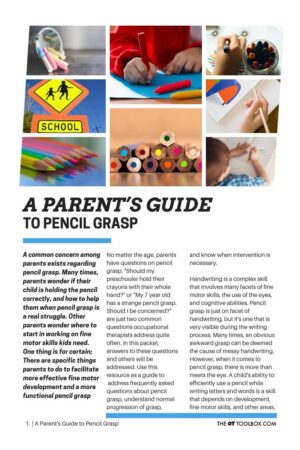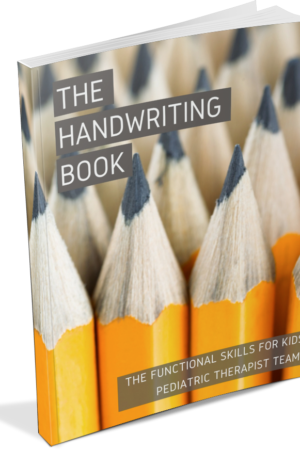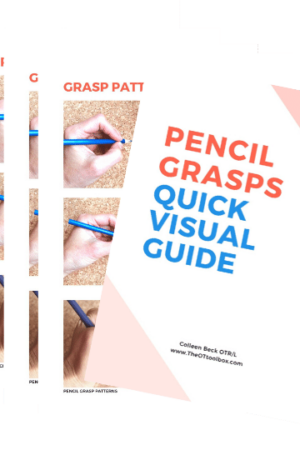Apple Play Dough Roll, Count, and Write Fine Motor Writing Sheets
$2.99
Children love play dough, carpets not so much. Teachers love writing, students not so much. Here is your chance to combine a love of playdough with the chore of writing. As an added bonus, these are apple themed, which will fit perfectly into your fall lesson plans. Today’s free printable, the Play Dough Roll, Count and Write – Apple Fine Motor Writing Sheets will build several different skills, while adding a little fun to the day.
Description
Play Dough Roll, Count, and Write
These apple fine motor writing sheets, included in today’s free PDF, can streamline your treatment or lesson plan by addressing several goals. Students will roll dough into different sized balls to fit them into the circles on the picture. Read below for different modifications to this activity. The focus of this lesson can be on one, two, or all of the skills outlined below.
Skills Addressed with Play Dough Roll, Count, and Write
- Kinesthetic awareness – This means learning by doing. Practice makes better
- Hand strength and dexterity – staying on the lines during writing, as well as rolling balls of Playdough, builds hand muscles and develops muscle control
- Visual motor skills –Combining what is seen visually and what is written motorically. It takes coordination to be able to translate information from visual input to motor output. Coloring, drawing, counting, cutting, and tracing are some visual motor skills.
- Pasting using drippy glue adds a sensory and strengthening element if you choose this modification
- Visual Perception – Scanning to find all the pieces, form constancy to build the correct ball and transform the lump of dough into a ball
- Proprioception – pressure on paper, grip on pencil, pressure on play dough
- Social/Executive Function – Following directions, turn taking, task completion, orienting to details, neatness, multi-tasking, attending to task, and impulse control can be addressed using these Apple Fine Motor Writing Sheets
- Handwriting: Letter formation – correctly forming the letters top to bottom. Letter sizing, spacing, line placement, directionality, and spelling are also addressed
- Copying – copying words from a model, transferring the letters from one place to another if your design offers a writing sample
- Bilateral coordination – remembering to use their “helper hand” to hold the paper while writing. Using one hand for a dominant hand instead of switching back and forth is encouraged once a child is in grade school or demonstrates a significant strength in one or the other.
- Strength – core strength, shoulder and wrist stability, head control, balance, and hand strength are all needed for upright sitting posture and writing tasks.
Ways to use and modify the Play Dough Roll, Count, and Write Activity
- Lowest level learners can dictate what they would like written on the page
- Middle level learners can copy a sentence from a model (on the board or right above it)
- Higher level learners can write a sentence or short paragraph. Learners might need an example, or prompt to get started.
- Laminate the page for reusability. This saves on resources, and many learners love to write with markers! Note: some children love wipe off sheets, while others become upset that they can not take their work with them. Offer to take photos of their work to record data or send home
- Make this part of a larger lesson plan including gross motor, sensory, social, executive function, or other fine motor skills. These Apple Play Dough Shape Cards are another great use of apple and play dough
- This Apple Visual Perception pack might enhance your lesson plan
- More or less prompting may be needed to grade the activity to make it easier or harder. Document how much verbal and physical assistance your learner needed
- Use other manipulatives instead of play dough:
- Crumpled tissue paper with drippy glue – Drippy wet glue is messy, and not as convenient as glue stick, however it is superior for different reasons. The added benefit is the sensory input from touching the wet glue, as well as fine motor strengthening from squeezing the bottle
- Small items like pompoms, buttons, coins, pieces of paper, paper clips, mini erasers, or a handful of screws from the junk drawer
- Glitter glue!
- Theraputty – this provides resistance for increased strengthening
- Color the small circles on the page
- Use bingo markers to make dots – these are colorful, fun to use, and adds a proprioceptive element of banging it on the paper
- Glue apple seeds onto the paper, make apple pies or caramel apples, and plant seeds
Other Apple Resources on the OT Toolbox
Apple Search for general apple themed blog posts and resources
Apple Therapy Kit Deal– has over 100 pages of apple themed worksheets and games. This kit helps develop fine motor, visual motor, visual perceptual, gross motor, and sensory development
Apple Brain Breaks – Brain breaks help students focus and pay attention in the classroom environment. Students who can not sit still for long periods of time often need periodic breaks to refocus and organize themselves.
10 Apples Up on Top Pre-writing Activity – Based on the popular book by the same name, this activity promotes fine motor skills needed for writing. Add some simple red pony beads and this activity is sure to be a hit!
However you choose to use these free Play Dough Roll, Count and Write – Apple Fine Motor Sheets, embrace the fun (and mess) that a great fall theme can provide.






